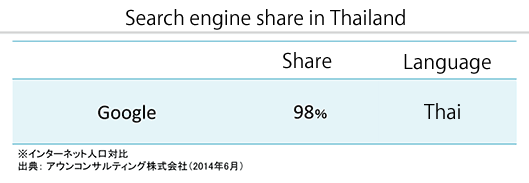A brick-and mortar travel agency in Japan wanted to attract more foreign visitors (Thai Tourists) to expand their business.
Simple enough. So how did they do it?
By using 4 web marketing strategies, this Japan-based travel agency was able to increase their bookings by 7.5 times in just 3 months – all by leveraging their already existing website.
The Problem
The travel agency had a particularly strong footing in the Hakone area and has a very good reputation in the Kanto area. Because of this, they decided to offer tours for Thai tourists in the Hakone area.
Unfortunately, there were three main issues with this strategy:
1. The Hakone area is not well known among Thai tourists
2. The travel agency is not well known
3. The travel agency has a small budget for advertising
As if attracting Thai tourists wasn’t a big enough challenge, the website came with issues as well:
1. The site is not available in Thai. Only in English, Chinese & Korean
2. The online booking forms had too many fields to fill out and users were exiting during the booking process.
3. The design of the website was outdated
Because of the small budget, localizing the website to Thai and doing a complete renewal of the website was out of the question. As grim as it looked, the travel agency decided to push on without addressing the web issues. They believed it could be done by if they accomplished the following targets within a 3-month period:
- Effectively persuade people to travel in the Hakone area (existing demand)
-
Run promotions to stimulate travel demand in the Hakone area (latent demand)
The Solution: 4 web marketing strategies
- Listing advertisement
- Google Display Network / Re-marketing
- Google Display Network / Manual Placements
- Analysis of the website
1. Listing advertisement
The first thing to look at is how Thais behave when making travel plans. First, they search the net for places they want to go. Next they assess and compare search engine results from high-ranking travel agencies. They then decide on which one is cheap and reliable before finally making their purchase or reservation.
With this in mind, the travel agency thought that making travel related promotions on the web could have a significant impact. The agency decided to go with Google as their search engine because Google’s share in the search engine market in Thailand is more than 98%.
“Travel” was chosen as the primary keyword for advertising and “tour” was chosen as the ad group keyword. Keyword combinations relevant to the area, tourism, and other proper nouns were also chosen.
Based on the characteristics of the keywords, the total number of searches for the keywords was about 5,000 times per month including “Hakone”.
The number of searches was higher in comparison with searches for Japanese local cities and since the search parameter of keywords list is short, “Japan” and “Tokyo” were also included.
2. Google Display Network (GDN) / Re-marketing
Most visitors land on the page through listing ads and placements but leave the site right after browsing to visit other sites for comparison before booking. This meant that it was very important to remind users about “Hakone area” and encourage them to revisit the site by implementing re-marketing ads.
At Google, the re-targeting network is called re-marketing and in Yahoo, it’s called re-targeting. This basically means that users who visit the company website are shown advertisements that prompt them to revisit the company site after they leave. It is also referred to as follow-up advertising.
Although implementation was limited due to budget constraints, changing banner ads accordingly to the page being visited can increase the effectiveness of the ad. In addition, modifying the duration of re-targeting ads and setting the number of impressions can make ads more effective as well.
3. Google Display Network (GDN) / Placements
Text listing ads mentioned earlier are a great way to spread the word about Hakone and build awareness for both the agency and the location. But the ads themselves won’t do you much good.
The placement of the ads is equally important as well. Take Japan for example. While Google has more than 98% market share in Thailand and therefore favors GDN, the Yahoo display ad network is more popular in Japan.
Once you get the ad network down, the next stage is narrowing down on the advertising medium and location.
The image above is for the site Marumura. It is quite the popular website among Thais and on this site, they can look for travel information about Japan. By narrowing down the advertising medium, it increases the efficiency of the ad.
In addition, many Thai Web media use the Google ad-serving platform (Google Adsense), which can provide a lower CPC or CPM than that of pure ads. Conversely, pure advertising is high-priced in media companies and it is not recommended for purposes other than maximizing exposure for brand awareness due to the poor cost-effectiveness.
4. Site Analysis: Identify Bottlenecks
Our first three strategies encourage customers to visit/revisit the site by building awareness and hooking readers to visit the site. However, if users don’t make a booking reservation, it won’t mean anything. For this, you must monitor user behavior on the site, as it is important to facilitate continuous improvement. The following list is provided as a reference.
♦ High Exit Ratios
Currently, only the English pages of the site are viable references when making Thai pages in the future. These are the pages users often view shortly before the leave the site – making this a bottleneck.
♦ Online Booking Form
Because there are too many fields to fill out, making the booking form unnecessarily complicated, cases where users dropped out before completing the booking procedure occurred.
♦ Product Development Ideas for Thailand
When doing listing ads, looking at the search queries revealed user needs. Consequently, the keywords list was able to provide ideas for creating content and tours Thais are interested in.
♦ Devices and Area Analysis in Thailand
A list of information was made for areas that have a large number of access points and devices that are commonly used in Thailand.
Two weeks after running advertisements, we take a look at the results and make further improvements
An effect analysis was conducted after two weeks. Although ad impression and click-through remained as expected, almost no new bookings were made.
That’s not good.
The following are the results of analyzing users.
- Listing ads bounce rate were about 70% and average visit duration was about 1 minute and 50 seconds.
- Display ads (banner ads) had a bounce rate of 75% and about 1 minute of average visit duration.
With a high bounce rate and a short visit duration, cases of non-completed bookings increased. As expected, the barrier for booking was high because of the English only areas and complicated forms.
Even knowing that information, dealing with the site system and language wasn’t a viable option yet so we implemented 4 measures for improvement.
Improvement measure 1: Place booking form link buttons to other parts in the landing page in addition to the link button in the first view.
The page structure is structured in a way that made it hard for users to see the bookmarking link. We had to find better placements for the buttons.
Improvement measure 2: The listing ad and banner ad hyperlink destinations were subdivided.
In order to maximize the traffic inflow to the booking page, listing ads and banner ads were revised to direct users from the entry page to the booking page.
Improvement measure 3: Change the targeted area from Thailand to Bangkok.
By viewing the results of the ad distribution in different locations on Google AdWords, the following results were obtained in the Bangkok area in Thailand. The results looked very promising.
⇒ 7% of ad impressions came from Bangkok
⇒ 8% of conversions came from Bangkok
Still, it was hard to say that the numbers were highly accurate. Taking the population and income level into consideration, I decided that concentrating our ad distribution in the Bangkok area would be effective so I narrowed the area down from Thailand, to Bangkok.
Improvement measure 4: Change the delivery method.
By comparing the device-specific data in Google Analytics, we saw that inflow results from Thailand were about 30% smartphone. This ratio is higher than the entire site’s numerical value and it was determined that access from smartphones were essential in Thailand.
On the other hand, since the target site has no support for smartphone users, when compared to the traffic inflow via PC and tablet, the bounce rate was high, the average page views were low, and visit durations were short. It was clear that making a site optimized for mobile was going to be important but we didn’t have the capacity for it in our current stage. So I controlled the bid to mobile terminal in Google AdWords.
It should be noted that in addition to area segmentations in Google AdWrods, delivery segmentations such as gender and age could also be selected. But beware when using these as targeting methods because of low accuracy.
Results after 3 months: Bookings has increased 7.5 times
Comparing the results of the first month and the third month since implementing the measures, we saw the following results.
∗Bounce rate and visit duration numerical values are from listing ads
By utilizing the information obtained from a third month, we decided on a renewal of the site.
The following would be renewed:
- Usability of the booking form
- Smartphone compatibility and other functional aspects
- Search query data for SEO
As soon as the site renewal is completed, online marketing in Thailand will be carried out.
Not all optimizations were necessarily implemented because of the short 3-month term of the project. However, in terms of time and cost, we were able to reach our improvement goals by implementing effective measures to produce results.
In Conclusion
In our case study, the industry was in Japan. However, it is essential to have someone in the company who is knowledgeable in the inbound and outbound marketing for the target country. This is essential when conducting any marketing.
The second important factor is that there must be local marketers and marketing channels. Even if there’s an experienced person in Japan, since he/she is in Japan and not in the actual location where you are marketing, their insight and sensitivity to information will be lowered and implementation of strategic measures and tactics will be affected.
It is important to consider these two factors when selecting your agency or consultant.
Not knowing the language and customs can have an impact when conducting online marketing designed for foreigners. That being said, the record 13.4 million foreign visitors to Japan was broken last year and has become a big topic in Japan. As we get closer to the 2020 Olympics, increased efforts to promote the country’s tourism industry has become a trend.
With this in mind, why not try attracting foreign customers even if it is something small. Do something that you can easily do like creating a flyer in English for example.
It’s a lot more risky to do nothing and miss out on the opportunities. Hopefully this case study will be useful to you and your business when it comes to attracting foreign customers.
Author of this article
Riku Saitou
I joined AUN consulting company in 2009 and worked under the sales division engaged in sales and consultations for search engine marketing (SEM) which is the main business. In May 2012, I went to Thailand as a legal person for the same company. In Thailand, I gave support to more than a hundred Japanese and Thai companies, from a wide range of industries; from B to B, such as manufacturing and travel, to B to C such as real estate. Currently, as a manager, I oversee the sales and consulting department in Thailand.
Hideki Yamakura
I joined AUN consulting company in April 2008 and I’m first level web analyst. After experiencing new customers who are operating in the search engine marketing (SEM), I am currently a consultant for SEM involved in the planning and execution of the marketing strategy for a wide range of leading industry companies in finance, Ecommerce and real estate. I have proven my expertise to more than a hundred companies; domestic and international. Now, I oversee the SEM consulting department as the manager.
 Login as
Login as
















